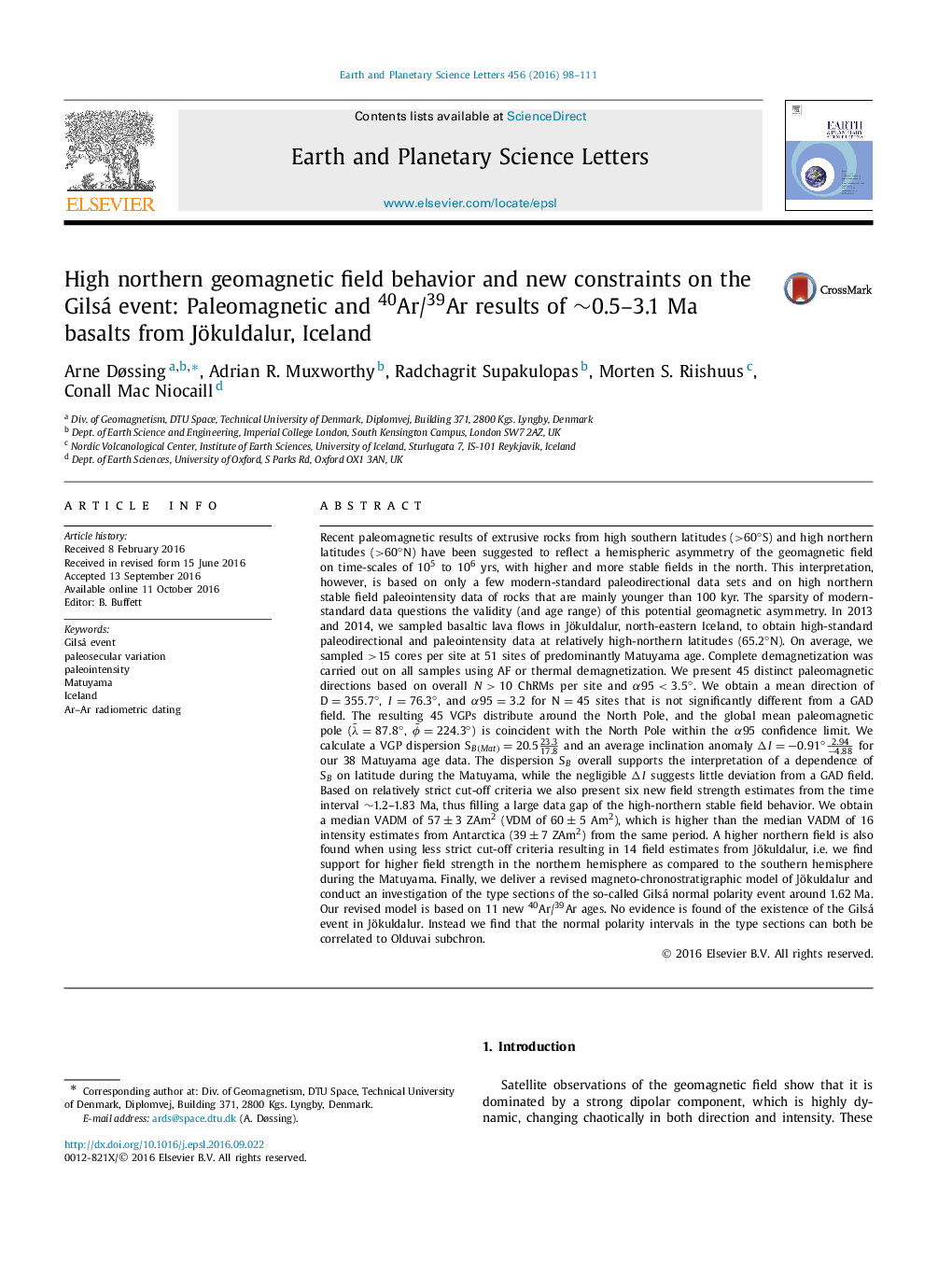| کد مقاله | کد نشریه | سال انتشار | مقاله انگلیسی | نسخه تمام متن |
|---|---|---|---|---|
| 6427072 | 1634700 | 2016 | 14 صفحه PDF | دانلود رایگان |

- Stable field, high standard full-vector data of 0.5-3.0 Ma rocks from Iceland.
- 45 paleodirectional results and 7 Matuyama field strength estimates.
- VGP dispersion values 2-3° lower than previous results from Iceland.
- Paleointensity results support a long-lived hemispheric asymmetry during Matuyama.
- New 40Ar/39Ar results show that the Gilsá normal polarity event does not exist.
Recent paleomagnetic results of extrusive rocks from high southern latitudes (>60°S) and high northern latitudes (>60°N) have been suggested to reflect a hemispheric asymmetry of the geomagnetic field on time-scales of 105 to 106 yrs, with higher and more stable fields in the north. This interpretation, however, is based on only a few modern-standard paleodirectional data sets and on high northern stable field paleointensity data of rocks that are mainly younger than 100 kyr. The sparsity of modern-standard data questions the validity (and age range) of this potential geomagnetic asymmetry. In 2013 and 2014, we sampled basaltic lava flows in Jökuldalur, north-eastern Iceland, to obtain high-standard paleodirectional and paleointensity data at relatively high-northern latitudes (65.2°N). On average, we sampled >15 cores per site at 51 sites of predominantly Matuyama age. Complete demagnetization was carried out on all samples using AF or thermal demagnetization. We present 45 distinct paleomagnetic directions based on overall N>10 ChRMs per site and α95<3.5°. We obtain a mean direction of D=355.7°, I=76.3°, and α95=3.2 for N=45 sites that is not significantly different from a GAD field. The resulting 45 VGPs distribute around the North Pole, and the global mean paleomagnetic pole (λ¯=87.8°, ϯ=224.3°) is coincident with the North Pole within the α95 confidence limit. We calculate a VGP dispersion SB(Mat)=20.523.317.8 and an average inclination anomaly ÎI=â0.91°2.94â4.88 for our 38 Matuyama age data. The dispersion SB overall supports the interpretation of a dependence of SB on latitude during the Matuyama, while the negligible ÎI suggests little deviation from a GAD field. Based on relatively strict cut-off criteria we also present six new field strength estimates from the time interval â¼1.2-1.83 Ma, thus filling a large data gap of the high-northern stable field behavior. We obtain a median VADM of 57±3ZAm2 (VDM of 60±5Am2), which is higher than the median VADM of 16 intensity estimates from Antarctica (39±7 ZAm2) from the same period. A higher northern field is also found when using less strict cut-off criteria resulting in 14 field estimates from Jökuldalur, i.e. we find support for higher field strength in the northern hemisphere as compared to the southern hemisphere during the Matuyama. Finally, we deliver a revised magneto-chronostratigraphic model of Jökuldalur and conduct an investigation of the type sections of the so-called Gilsá normal polarity event around 1.62 Ma. Our revised model is based on 11 new 40Ar/39Ar ages. No evidence is found of the existence of the Gilsá event in Jökuldalur. Instead we find that the normal polarity intervals in the type sections can both be correlated to Olduvai subchron.
Journal: Earth and Planetary Science Letters - Volume 456, 15 December 2016, Pages 98-111